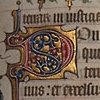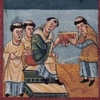Orbis
a rotunditate circuli
dictus,
quia sicut rota est,
unde breuis etiam rotella
orbiculus appellatur. |
orbis...dictus [est] = orbis sic nominatur
[orbis] rota est |
| |
Hrabanus now moves on to orbis, and he begin by showing that an
orbis is a rota, just as a rotella (diminutive of rota) is the same as an
orbiculus (diminutive of orbis). |
Vndique enim circumfluens
Oceanus eius in circuitu ambit fines. |
Oceanus ambit in circuitu fines eius |
 |
the world is an orbis: what flows around the perimeter of the
orbis? |
Significat ergo
aut totum mundum
iuxta historiam
aut iuxta allegoriam
uniuersalem aecclesiam, |
[orbis] significat totum mundum
parallel structure: [orbis significat] universalem aecclesiam
aecclesiam = ecclesiam [hypercorrection]
|
| |
Hrabanus wants to give two different interpretations of the orbis:
one interpretation is "historical" and the other interpretation
is "allegorical." what are these two different meanings of orbis? |
aut in contrariam partem
impios
qui frequenter
terrae appellatione
declarantur. |
parallel structure: [orbis significat] impios
[in contrariam partem = the same allegorical style as "in malum"] |
| |
in addition to these two meanings, Hrabanus reminds us that there
is an interpretation in contrariam partem (in malum), in which the world
symbolizes sinners; we saw this in the passage you read about terra |
De quibus Psalmista ait:
"Iudicabit orbem
terrae
in iustitia
et populos in aequitate." [...] |
[dominus] iudicabit orbem terrae
[see Psalm
97 (98); also Psalm
9 and Psalm
95 (96)] |
 |
here Hrabanus shows the phrase "orbis terrae" being
used in the Bible as a symbol of sinners: what is God going to do to the
orbem terrae = impios...? |
Iterumque
centesimus sextus Psalmus
quatuor cardinibus
terrae spatia conprehendit
dicens:
"A solis ortu et occasu,
ab aquilone et mari." |
cardinibus: s.v. cardo
solis: s.v. sol
aquilone: s.v. aquilo
[the verse is from Psalm
106 (107)] |

a solis ortu |
at the same time that Hrabanus found the phrase "orbis terrae"
in the Bible, he also finds the description of the earth as a place with
four corners or cardinal points: what are the four cardinal points? |
cuius rei
euidentissimum
quoque euangelii extat exemplum,
ubi dicit:
"Emittet angelos suos
cum tuba et uoce magna
et congregabit
a quatuor angulis terrae." |
cuius: relative
pronoun at "beginning" of sentence [= huius rei]
parallel structure: congregabit [angelos suos] a quatuor angulis
[passage is Matthew
24] |
 |
Hrabanus also finds the same image of a square, with four angles,
in the Gospels: this is a big problem! how can an orbis have four anguli? |
Vnde merito estimo
perquirendum,
quemadmodum terra possit
et quadratio et circulus
conuenire,
dum scemata ipsa
(sicut geometrici dicunt)
uideantur esse diuersa. |
merito: s.v. meritum
perquirendum [esse]: indirect
statement
quemadmodum possit: indirect
question
schemata: Greek plural (schema, schemata)
dum... videantur: dum + subjunctive |
| |
on whose authority does Hrabanus say that a circulus and a quadratio
are not the same thing? |
Formam terrae
ideo scriptura
orbem uocat
eo quod
respicientibus extremitatem eius
circulus semper appareat,
quem circulum
Greci orizonta uocant. |
scriptura vocat formam terrae "orbem" [see passage from Psalms
cited above]
orizonta = horizonta (Greek plural: horizon, horizonta)
semper appareat [esse] circulus |
| |
Hrabanus returns to the idea of the earth as an orbis, a circulus:
Hrabanus says that you can see the curvature of the earth by looking at
the horizon. where does the word horizon come from? |
Quattuor autem cardinibus
eam formari dicit,
quia quattuor cardines
quattuor angulos quadrati
significant,
qui
intra praedictum terrae circulum
continentur. |
[scriptura] dicit eam formari: indirect
statement
quadrati: genitive singular of quadratus |
| |
Hrabanus now proposes a way to reconcile the square and the circle.
how is it possible for a square and a circle to coexist? |
Nam si ab orientis cardine
in austrum et in aquilonem
singulas rectas lineas ducas, |
orientis: s.v. oriens
austrum: s.v. auster |
| |
Hrabanus now describes, step by step, how you can inscribe a square
inside a circle. what is the first thing that you do? |
similiter quoque
et si ab occidentis cardine
ad praedictos cardines,
id est austrum et aquilonem
singulas rectas lineas tendas,
facis quadratum terrae
intra orbem praedictum, |
occidentis: s.v. occidens |
| |
what lines to you add to this drawing in order to come up with
a square inscribed in the circle? |
sed quomodo quadratus iste demonstratiuus
intra circulum
scribi debeat,
Eoclides
in quarto libro Elementorum
euidenter insinuat; |
scribi: present passive infinitive
quomodo...debeat: indirect question
Eoclides = Euclid (see
a demonstration of Proposition 6) |
 |
where does Hrabanus find the geometrical proof for the procedure
of inscribing a circle inside a square? |
quapropter
recte scriptura sancta
faciem terrae
et orbem uocat,
et quattuor eam dicit cardinibus contineri. |
faciem: s.v. facies
dicit... eam contineri: indirect
statement |
| |
what does Hrabanus conclude about the fact that, according to
the Bible, the world is both an orbis and a square with quattuor cardines? |





